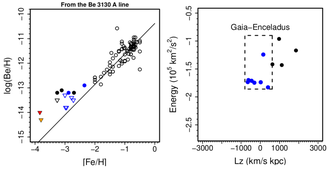
How can we study the first stages of the Milky Way chemical enrichment process? One way seems to be determining the abundance of the light element beryllium (Be) in old, extremely metal-poor stars. Such stars are very old, formed in the first stages of the Milky Way chemical enrichment. They contain chemical elements in amounts that are at least
1000 times less than what is found in the Sun.
The element beryllium is of interest because it can only be formed by cosmic ray spallation in the interstellar medium. This means that it is formed by fission reactions, when heavier elements (mainly oxygen) are broken into smaller pieces. Since cosmic rays travel across the Galaxy, the production of beryllium is a widespread and somewhat homogeneous process.
When investigating the abundances of Be in a sample of extremely metal-poor stars, a team lead by Rodolfo Smiljanic from CAMK found a large scatter in the relation between the abundances of Be and iron (Fe). The scatter is related to where the stars were formed. Stars formed in Gaia Enceladus, a dwarf galaxy that merged with the Milky Way about 8 to 10 Gyr ago, fall in a different place in the Be vs. Fe diagram when compared to stars formed in the Milky Way.
As the Be abundances are expected to be more or less the same for stars formed at the same time, the scatter in the Be vs Fe diagram was interpreted as mainly caused by Fe. Stars formed at more or less the same time have very distinct abundances of Fe because of the different conditions in the regions where they were formed. The research results suggest that beryllium abundances are ideal to expose the variation of chemical enrichment across the early Milky Way.
This research was funded by an OPUS grant from NCN. The results were recently published in A&A:
Figure caption:
Left: The diagram of beryllium abundances as a function of iron abundances. The extremely metal-poor stars analyzed in this work are marked as black solid circles or triangles, if they were formed in the Milky Way, or as blue circles and triangles, if they were formed in Gaia Enceladus. The other points are stars taken from other works. Right: Gaia Enceladus stars, inside the dashed box, can be identified using the angular momentum (Lz) and energy of their orbits across the Galaxy.






